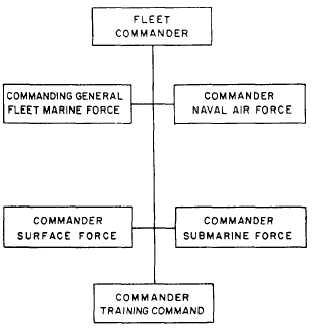attention. They then develop programs and order
priorities to resolve those problems through the best use
of all headquarters and field resources.
NAVSEC and its field divisions use their expertise
in every step of the fleet support process, and a
NAVSEC engineer visiting a ship may be the first to
receive a problem. Ships nearly always need NAVSEC
technical assistance to investigate, evaluate, and define
the problems. Under NAVSEA direction, NAVSEC
engineers often develop and become managers of large
and small programs to solve the operators’ material
problems.
AFLOAT STAFFS
A fleet is usually divided into forces, flotillas,
squadrons, groups, and wings for administrative
purposes. Forces are called type commands
(TYCOMs). For example, the COMMANDER
SURFACE FORCE shown in figure 7-1 is a TYCOM.
The TYCOM is responsible for all of the ships within
his force, which may include flotillas, squadrons,
groups, and wings. This general organizational
structure applies to both the Atlantic and Pacific Fleets,
but may vary from staff to staff.
Service squadrons under the surface force
commander handle the mobile supply and logistics
responsibilities for the surface and submarine forces. To
help you better understand a TYCOM organization, we
Figure 7-1.-A fleet-type organization.
will discuss the TYCOM’S responsibilities in the
following section.
RESPONSIBILITIES OF TYPE
COMMANDERS
TYCOMs issue any necessary instructions for the
operation, maintenance, and administration of ships of
the type. These instructions amplify manuals,
regulations, and other directives issued by higher
authority. TYCOMs exercise operational control of
ships and units until they assign control to other
commanders. They also maintain standards by holding
administrative, operational readiness, and material
inspections.
TYCOMs supervise the allowance of personnel
within the type, and they plan and recommend
personnel policies to the fleet commander. They
establish training requirements in the offensive and
defensive use of all armament and equipment for ships
and aircraft within the type.
TYCOMs are responsible for material matters
within their commands. In logistic matters, they are
responsible for all areas of readiness and performance
of their forces. However, the service squadron, air
force, marine force, and sea frontier commands have
special overall logistic responsibilities.
The Atlantic and Pacific Fleets respectively issue
regulations that explain the TYCOM’s general and
specific ship maintenance responsibilities. The
regulations of both fleets are similar, but not identical.
In general, the TYCOM’s have the following
responsibilities:
l Ensure the material readiness of ships assigned
to them. Maintain the ship’s hull, propulsion machinery,
guns, and other equipment so the ship can carry out any
assignment within its capacity.
. Hold material inspections of ships under the
TYCOM’s administrative command; use personnel who
arc not attached to the ship being inspected for this
purpose. The ship disassembles a large amount of
machinery for this inspection to give the inspectors an
in-depth look at conditions.
. Establish effective procedures and programs for
progressive self-maintenance, and enforce compliance.
Hold special inspections of specific machinery or
equipment, prepare routine maintenance checkoff lists,
monitor all material failures to detect possible trouble
areas and take corrective action, review routine reports,
7-3


